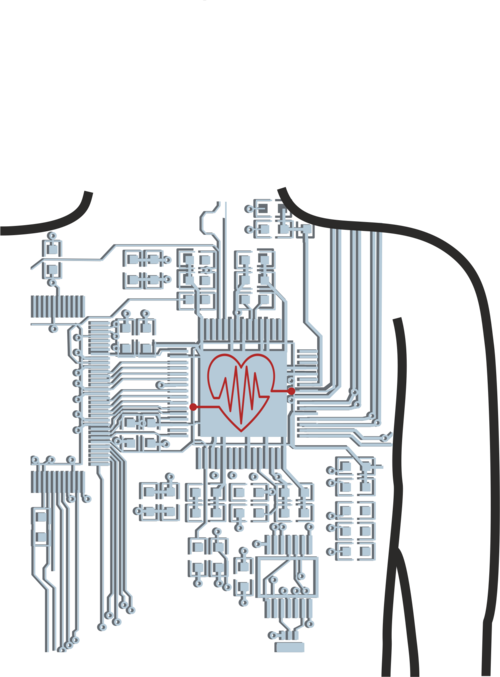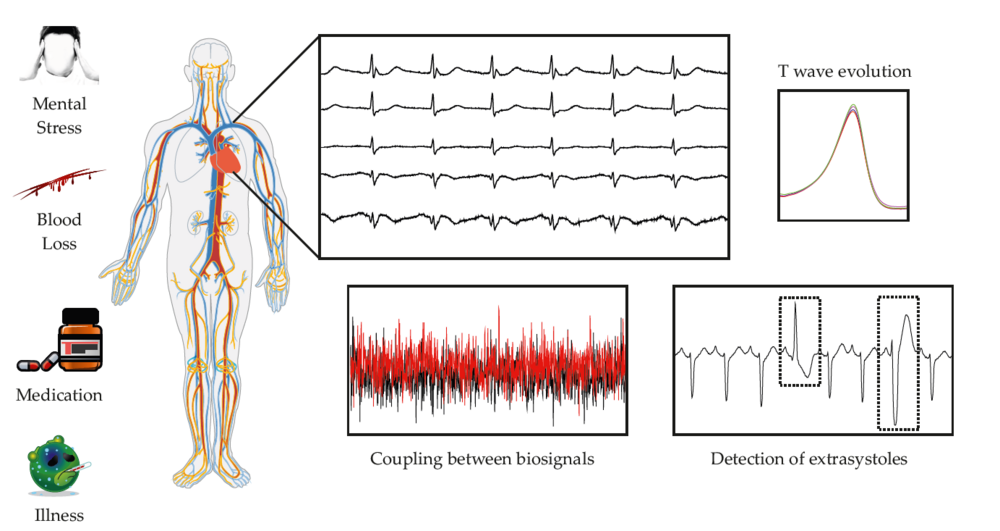Project description
Current investigations focus on the electrocardiogram (ECG) which is a well-established and easy to obtain physiological signal of remarkable diagnostic power. It provides a wide spectrum of information regarding a patient‘s condition. However, the clinically relevant information is often transient or masked by noise and therefore hard – if not even impossible – for the human observer to detect and interpret. In general, consistent interpretation of ECG phenomena is a difficult task due to inter-patient and inter-observer variability. This research aims to develop analysis tools that provide reliable parameters and predictors for distinct diseases, thereby supporting practicing clinicians in their daily business.
The electrocardiogram (ECG) is one of the most used biomedical signals for diagnosing cardiovascular diseases. As shown in the figure below, it reflects the internal or external influences onto our cardiovascular system, as e.g. mental stress, medication, or illness. Diagnoses for specific diseases are usually based on clinically established parameters, such as unnatural changes in the heart rate, disturbances in the heart rhythm, or obvious changes of the ECGs’ morphology. Although these parameters are, due to their simplicity and interpretability, extremely useful for physicians, they do not provide information about subtle changes of the underlying ECG. A subtle change in the ECGs’ morphology however, could be a crucial indicator for a specific pathology and could therefore support physicians in the diagnosis procedure.
Ph.D. Project Facts
ISP Research Team
Carl Böck
Péter Kovács
Christoph Mahringer
Mario Huemer
Duration
Apr. 2016 - Mar. 2020
This Ph.D. project focuses on the extraction and visual representation of hidden information in the ECG. Unfortunately, this information is not only super-imposed by well-known noise sources, such as baseline wander, muscle noise, etc., but also by physiological noise, introduced, for example, by a changing respiratory rate. Consequently, such influences have to be eliminated before extracting the diagnostic information. Considering this, the long-term variability and changes of the ECG morphology are analyzed and evaluated in terms of their medical usefulness. For that reason we use specific signal transformations in order to represent the crucial information in a low-dimensional space. Particular attention is paid on the interpretability of the extracted information, such that physicians are supported but not replaced in decision-making.


Publications
3) Böck C., Lunglmayr M., Mahringer C., Mörtl C., Meier J., Huemer M.: Global Decision Making for Wavelet Based ECG Segmentation: Computer Aided Systems Theory - EUROCAST 2017, Serie Lecture Notes in Computer Science, Vol. 10672, Springer International Publishing, Cham, Seite(n) 179--186, 2018
2) Kovács P., Böck C., Meier J., Huemer M.: ECG Segmentation Using Adaptive Hermite Functions: Proceedings of the ASILOMAR Conference on Signals, Systems, and Computers, IEEE, Seite(n) 1476-1480, 2017
1) Struhal W., Mahringer C., Lahrmann H., Mörtl C., Buhl P., Huemer M., Ransmayr G.: "Heart Rate Spectra Confirm the Presence of Autonomic Dysfunction in Dementia Patients," in: Journal of Alzheimer's Disease, Volume 54, Number 2, Page(s) 657-667, 2016.